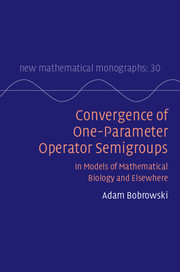Book contents
- Frontmatter
- Colophon
- Contents
- Preface
- 1 Semigroups of Operators and Cosine Operator Functions
- PART I REGULAR CONVERGENCE
- 2 The First Convergence Theorem
- 3 Continuous Dependence on Boundary Conditions
- 4 Semipermeable Membrane
- 5 Convergence of Forms
- 6 Uniform Approximation of Semigroups
- 7 Convergence of Resolvents
- 8 (Regular) Convergence of Semigroups
- 9 A Queue in Heavy Traffic
- 10 Elastic Brownian Motions
- 11 Back to the Membrane
- 12 Telegraph with Small Parameter
- 13 Minimal Markov Chains
- 14 Outside of the Regularity Space: A Bird's-Eye View
- 15 Hasegawa's Condition
- 16 Blackwell's Example
- 17 Wright's Diffusion
- 18 Discrete-Time Approximation
- 19 Discrete-Time Approximation: Examples
- 20 Back to Wright's Diffusion
- 21 Kingman's n-Coalescent
- 22 The Feynman–Kac Formula
- 23 The Two-Dimensional Dirac Equation
- 24 Approximating Spaces
- 25 Boundedness, Stabilization
- PART II IRREGULAR CONVERGENCE
- PART III CONVERGENCE OF COSINE FAMILIES
- PART IV APPENDIXES
17 - Wright's Diffusion
from PART I - REGULAR CONVERGENCE
Published online by Cambridge University Press: 05 July 2016
- Frontmatter
- Colophon
- Contents
- Preface
- 1 Semigroups of Operators and Cosine Operator Functions
- PART I REGULAR CONVERGENCE
- 2 The First Convergence Theorem
- 3 Continuous Dependence on Boundary Conditions
- 4 Semipermeable Membrane
- 5 Convergence of Forms
- 6 Uniform Approximation of Semigroups
- 7 Convergence of Resolvents
- 8 (Regular) Convergence of Semigroups
- 9 A Queue in Heavy Traffic
- 10 Elastic Brownian Motions
- 11 Back to the Membrane
- 12 Telegraph with Small Parameter
- 13 Minimal Markov Chains
- 14 Outside of the Regularity Space: A Bird's-Eye View
- 15 Hasegawa's Condition
- 16 Blackwell's Example
- 17 Wright's Diffusion
- 18 Discrete-Time Approximation
- 19 Discrete-Time Approximation: Examples
- 20 Back to Wright's Diffusion
- 21 Kingman's n-Coalescent
- 22 The Feynman–Kac Formula
- 23 The Two-Dimensional Dirac Equation
- 24 Approximating Spaces
- 25 Boundedness, Stabilization
- PART II IRREGULAR CONVERGENCE
- PART III CONVERGENCE OF COSINE FAMILIES
- PART IV APPENDIXES
Summary
In spite of mutations that – given the state of a population – occur independently in each individual, members of (especially: small) populations exhibit striking similarities. This is due to genetic drift, one of the most important forces of population genetics. Simply put, the reason for this phenomenon is that in a population, on the one hand, new variants are introduced randomly by (neutral) mutations, and, on the other, many variants are also randomly lost as not all members of the current generation pass their genetic material to the next one.
This situation is clearly presented in the following model of Wright and Fisher [49, 134, 141]. We suppose the population in question to be composed of 2N individuals; in doing so we identify individuals with chromosomes (that come in pairs), or even with corresponding loci on these chromosomes. We assume there are only two possible alleles (variants) at this locus: A and a. The size of the population is kept constant all the time, and we consider its evolution in discrete non-overlapping generations formed as follows: an individual in the daughter generation is the same as its parent (reproduction is asexual) and the parent is assumed to be chosen from the parent generation randomly, with all parents being equally probable. In other words, the daughter generation is formed by 2N independent draws with replacement from the parent generation. In each draw all parents are equally likely to be chosen and daughters have the same allele as their parents. It should be noted here that such sampling procedure models the genetic drift by allowing some parents not to be selected for reproduction, and hence not contributing to the genetic pool.
Then, the state of the population at time n ≥ 0 is conveniently described by a single random variable Xn with values in {0, …, 2N} being equal to the number of individuals of type A. The sequence Xn, n ≥ 0 is a time-homogeneous
Markov chain with transition probabilities:
In other words, if Xn = k, then Xn+1 is a binomial random variable with parameter.
- Type
- Chapter
- Information
- Convergence of One-Parameter Operator SemigroupsIn Models of Mathematical Biology and Elsewhere, pp. 96 - 99Publisher: Cambridge University PressPrint publication year: 2016



